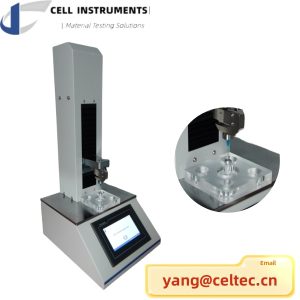최고의 ISO 8771-5 바늘 침투 테스트 장비
바늘 관통 시험 장비, 또한 ~로 알려짐 침투성 테스터, 포장, 식품, 의료 및 제약과 같은 다양한 산업에서 중요한 역할을 합니다. 이 기기는 바이알 마개의 품질과 안전을 보장하는 제약 산업에서 중요한 역할을 합니다. Cell Instruments는 ISO 8871-5에 명시된 표준을 충족할 뿐만 아니라 초과하는 장비를 제공하는 정밀 테스트 기술의 최전선에 서 있습니다.
ISO 8871-5는 침투성을 탄성체 폐쇄물을 뚫는 데 필요한 힘으로 정의합니다. 이 표준은 테스트 방법을 자세히 설명합니다. 많은 제약 탄성체 폐쇄물은 주사 바늘과 함께 사용됩니다. 뚫는 데 필요한 힘을 평가하는 것은 폐쇄물이 의도한 기능에 적합한지 평가하는 데 중요합니다. 테스트 절차는 주입 바늘과 밀봉을 장치에 고정하고, 관통될 때까지 수직력을 가하고, 최대 힘을 기록하는 것을 수반합니다.
Cell Instruments 바늘 침투 테스트 장비를 선택하는 이유
정확한 결과를 위한 정밀 PLC 제어
바늘 관통 시험에서 신뢰할 수 있고 일관된 결과를 얻으려면 정밀도가 가장 중요합니다. 고품질 바늘 관통 시험 장비는 재료 관통성을 정확하게 측정하기 위해 정밀 구성 요소로 설계되었습니다. 바늘 설계부터 모션 제어 시스템까지 모든 측면이 정밀한 시험 결과에 기여합니다.
ISO 8871-5 표준 준수
ISO 8871-5는 의료 분야에서 바늘 침투 테스트에 대한 표준을 설정하여 의료 기기 평가에 대한 특정 요구 사항을 설명합니다. 바늘 침투 테스트 장비는 이러한 표준을 준수하여 규제 요구 사항과 업계 모범 사례를 준수해야 합니다. 제조업체는 테스트 결과의 신뢰성과 유효성을 보장하기 위해 ISO 8871-5 준수를 우선시해야 합니다.
다양한 응용 프로그램을 위한 다재다능함
효과적인 바늘 관통 시험 장비는 다양한 재료와 시험 요구 사항을 수용할 만큼 다재다능해야 합니다. 포장재, 의료 기기 또는 제약 제품을 시험하든 장비는 바늘 구성, 관통 속도 및 시험 매개변수 측면에서 유연성을 제공해야 합니다. 다재다능함을 통해 사용자는 정확성이나 효율성을 손상시키지 않고도 장비를 다양한 시험 시나리오에 맞게 조정할 수 있습니다.
원활한 작동을 위한 사용자 친화적 인터페이스
사용 편의성은 생산성을 극대화하고 바늘 침투 테스트에서 오류를 최소화하는 데 필수적입니다. 사용자 친화적인 인터페이스는 작업을 간소화하여 작업자가 테스트를 설정하고, 매개변수를 조정하고, 결과를 쉽게 해석할 수 있도록 합니다. 직관적인 소프트웨어 인터페이스와 터치스크린 디스플레이는 사용성을 향상시켜 효율적인 테스트 프로세스를 가능하게 하고 신규 사용자의 학습 곡선을 줄입니다.
장기적 신뢰성을 위한 견고한 구조
내구성은 바늘 관통 시험 장비에서 중요한 요소이며, 특히 까다로운 산업 환경에서 그렇습니다. 고품질 소재를 사용한 견고한 구조는 장기적인 신뢰성과 성능 일관성을 보장합니다. 온도 및 습도 변화를 포함한 엄격한 테스트 조건을 견디도록 설계된 장비는 장기간에 걸쳐 신뢰할 수 있는 결과를 제공하여 가동 중지 시간과 유지 관리 비용을 최소화합니다.
효율성 향상을 위한 자동화된 테스트
자동화 기능은 바늘 침투 테스트 프로세스를 간소화하여 효율성과 처리량을 개선합니다. 자동화 장비는 정밀하고 일관되게 반복적인 테스트 작업을 수행하여 수동 개입의 필요성을 줄이고 운영자 오류를 최소화할 수 있습니다. 샘플 처리 시스템 및 데이터 로깅 기능과 같은 통합 자동화 기능은 테스트 작업의 생산성과 확장성을 향상시킵니다.
실시간 모니터링 및 데이터 분석
실시간 모니터링 및 데이터 분석 기능을 통해 사용자는 테스트 진행 상황을 모니터링하고 결과를 즉시 분석할 수 있습니다. 고급 바늘 침투 테스트 장비는 센서와 소프트웨어 시스템을 통합하여 침투력, 깊이 및 기타 중요한 매개변수에 대한 실시간 피드백을 제공합니다. 실시간 데이터 분석을 통해 신속한 의사 결정이 가능하고 향상된 품질 관리를 위한 프로세스 최적화가 용이해집니다.
교정 및 검증 기능
정확한 교정 및 검증은 바늘 침투 테스트 장비의 무결성과 정확성을 유지하는 데 필수적입니다. 내장된 교정 루틴 및 검증 프로토콜은 장비가 지정된 성능 매개변수 내에 있도록 보장합니다. 정기적인 교정 검사 및 검증 절차는 테스트 결과의 정확성을 확인하고 ISO 8871-5와 같은 국제 표준에 대한 추적성을 유지하는 데 도움이 됩니다.
운전자 보호를 위한 안전 기능
안전은 항상 바늘 관통 테스트에서 최우선 순위여야 하며, 작업자의 사고와 부상을 방지해야 합니다. 연동 메커니즘, 비상 정지 버튼, 보호용 인클로저와 같은 안전 기능은 고속 바늘 움직임과 샘플 취급과 관련된 위험을 완화합니다. 장비 설계는 테스트 효율성이나 정확성을 손상시키지 않으면서 작업자 보호를 우선시해야 합니다.
특정 요구 사항에 대한 사용자 정의 옵션
모든 테스트 애플리케이션에는 바늘 침투 테스트 장비의 사용자 정의가 필요할 수 있는 고유한 요구 사항과 과제가 있습니다. 제조업체는 바늘 구성을 수정하거나, 특수 센서를 추가하거나, 사용자 정의 소프트웨어 기능을 통합하든, 장비를 특정 산업 요구 사항에 맞게 조정하기 위한 사용자 정의 옵션을 제공해야 합니다. 사용자 정의를 통해 장비가 테스트 애플리케이션의 정확한 사양을 충족하고 성능과 안정성을 최적화할 수 있습니다.
바늘 침투 테스트 장비는 다양한 산업에서 재료와 제품의 품질과 안전을 보장하는 데 중요한 역할을 합니다. 정밀 엔지니어링, ISO 8871-5와 같은 표준 준수, 다재다능함, 자동화와 같은 기능을 우선시함으로써 제조업체는 사용자의 다양한 요구를 충족하는 고품질 장비를 제공할 수 있습니다. 견고한 구조, 사용자 친화적인 인터페이스 및 안전 기능은 바늘 침투 테스트 장비의 신뢰성과 사용성을 더욱 향상시켜 산업이 정확하고 효율적인 테스트 프로세스를 수행할 수 있도록 지원합니다.
자주 묻는 질문
- 질문: 바늘 침투 시험 장비가 다양한 바늘 구성을 수용할 수 있나요?
A: 네, 대부분의 최신 테스트 장비는 다양한 테스트 요구 사항과 샘플 유형을 수용하기 위해 바늘 구성에 유연성을 제공합니다. 사용자는 특정 응용 분야에 맞게 다양한 바늘 크기, 모양 및 소재 중에서 선택할 수 있습니다. - 질문: 바늘 관통 시험은 다른 재료 시험 방법과 어떻게 다릅니까?
A: 바늘 관통 시험은 바늘이 재료를 관통하는 용이성을 구체적으로 측정하는 반면, 다른 방법은 인장 강도나 탄성과 같은 다양한 재료 특성에 초점을 맞출 수도 있습니다.
A: 바늘 관통 시험 장비는 다양한 두께의 재료를 수용할 수 있나요? - 질문: 바늘 침투 시험 장비는 포장 산업에 어떤 이점을 제공합니까?
A: 이 시험 장비는 포장재의 펑크 저항성과 밀봉 무결성을 평가하여 보관 및 운송 중 제품의 안전성과 신선도를 보장하는 데 도움이 됩니다. - 질문: 바늘 침투 시험 장비를 의료 기기 시험에 사용할 수 있나요?
대답: 네. 이 장비는 의료 기기 산업에서 주사기 바늘이나 카테터와 같은 재료의 침투성을 평가하여 환자의 안전과 기기 효과성을 보장하는 데 일반적으로 사용됩니다. - 질문: 바늘 침투 시험 장비를 설치하고 사용하는 데에 대한 지원은 어떻게 받을 수 있나요?
A: Cell Instruments에서는 바늘 침투 테스트 장비의 설정, 사용 및 유지 관리를 돕기 위해 전담 고객 지원을 제공합니다. 저희 팀에 연락하시면 기꺼이 도와드리겠습니다.
참조
ISO 8871-5 비경구용 및 제약용 기기용 탄성 부품


